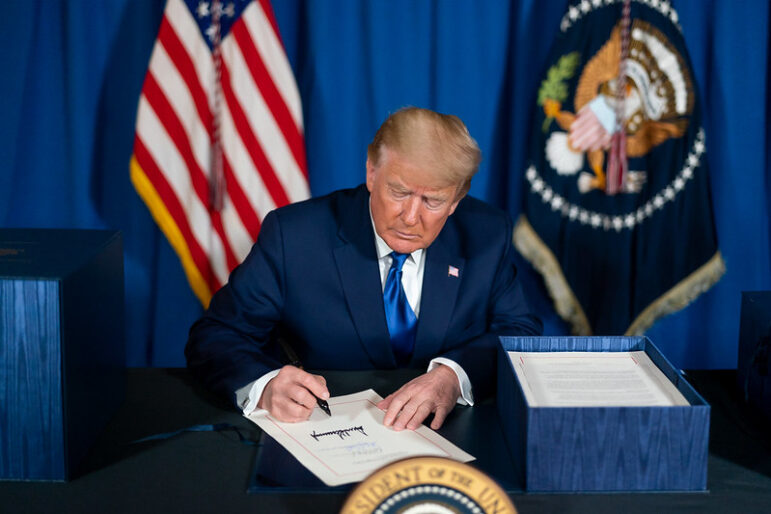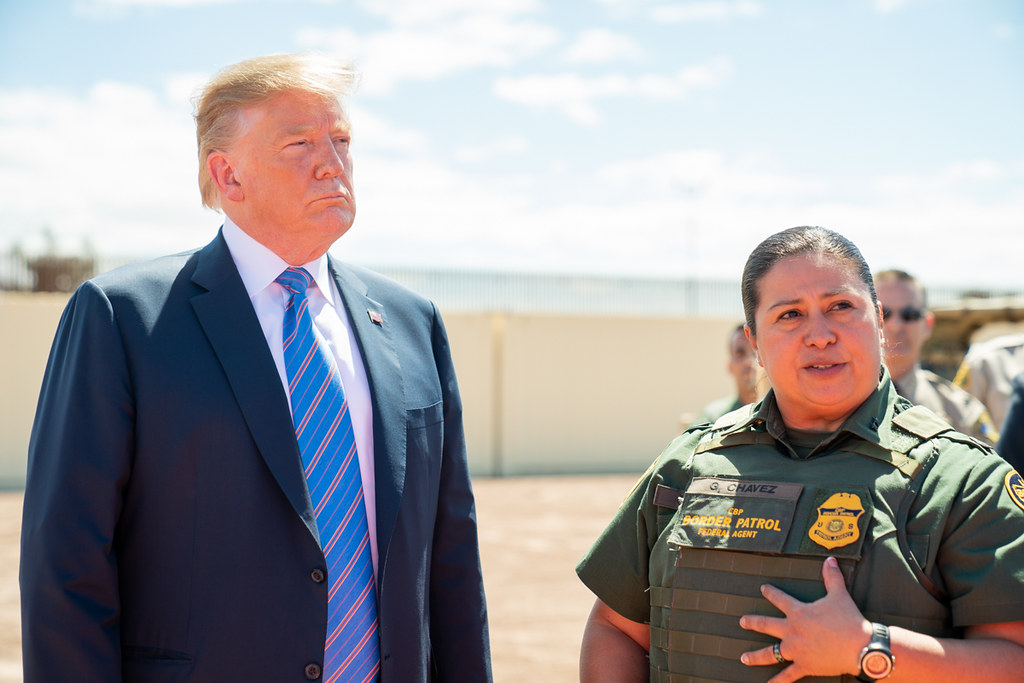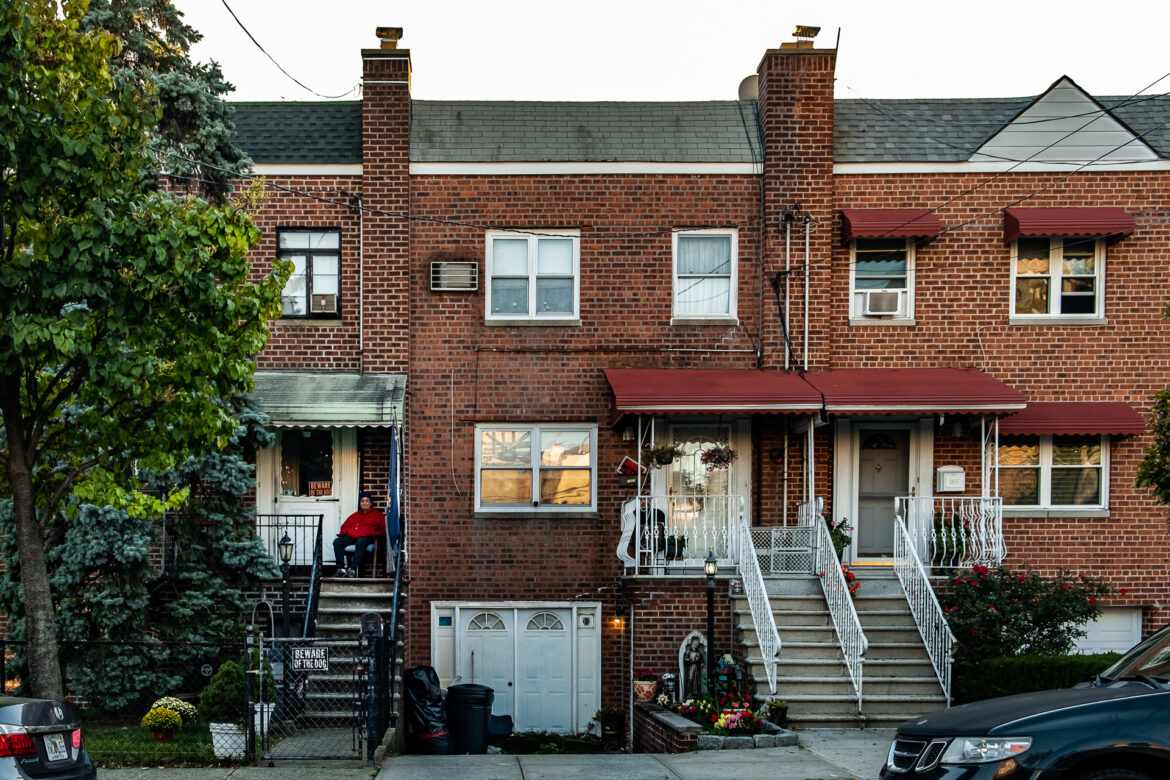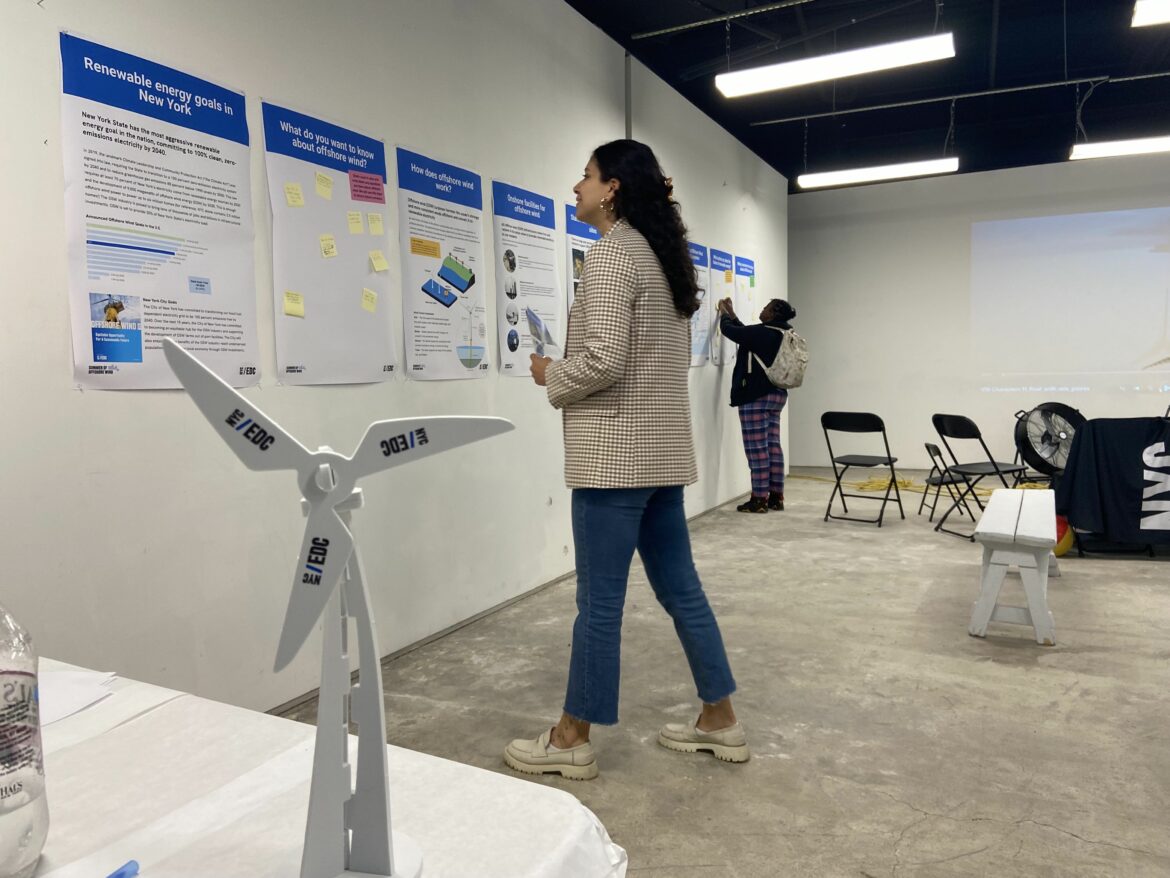With Donald Trump expected to return to the White House in January, City Limits takes a closer look at the former and future president’s platform and promises around key policy issues, and what that could mean in New York.

Official White House Photo by Shealah Craighead
Former President Donald Trump at a bill signing in 2020.Editor’s note: Portions of this story are adapted from prior City Limits’ coverage, published before the Nov. 5 election, which looked at what the two leading presidential candidates had proposed around housing, immigration and climate change.
More than 2.5 million New York City residents voted in Tuesday’s election. And while the majority of New Yorkers cast their ballots for Vice President and Democrat Kamala Harris—who earned nearly 68 percent of votes across the five boroughs—former President and Republican Donald Trump won out nationwide, and is expected to return the White House come January.
As was this case during his previous presidential term from 2016-2020, Trump’s leadership will have significant impact on how New York City operates. At a press conference Wednesday morning, Mayor Eric Adams—who, like Trump, is facing criminal charges—congratulated the candidate on his win, saying City Hall will “work with the incoming administration for the good of all New Yorkers.”
But he also pledged to “defend and fight for our city’s values as part of the process.”
“No matter who is president or what party controls Congress, this city will always stand up for the rights of women, our immigrant brothers and sisters, our LGBTQ-plus community and millions of others in New York,” Adams said.
But Trump’s promises on the campaign trail—in particular, his proposal to deport millions of immigrants across the country—has unsettled many in the city, which is home to roughly 3 million foreign-born residents, about 13 percent of whom are undocumented.
Below, City Limits takes a look at three key issues—immigration, housing and climate change—and what we know so far about the potential impact of Trump’s next term.
Immigration and immigrant communities
Trump’s immigration platform has focused on two core promises: to deport those already in the country without documentation, and “seal the border” to those who dare to come.
“We’re gonna have to seal up those borders,” Trump said during his acceptance speech early Wednesday morning, according to a transcript published by Newsweek. “We have to let them come back in, but they have to come in legally. They have to come in legally.”
Throughout his campaign, Trump has blamed undocumented people for many of the nation’s problems—inflation, lack of affordable housing, rising crime rates, low wages, insufficient disaster relief funds, and economic instability. He’s claimed, baselessly, that non-citizens would vote illegally in the November election and that immigrants with “bad genes” are committing murders.
On Oct. 11, Trump visited Aurora, CO, and delivered a nearly 90-minute speech filled with extreme anti-immigrant rhetoric. He said that if reelected, he would implement an initiative called “Operation Aurora” to detain and deport undocumented immigrants accused of crimes under the Alien Enemies Act of 1798, invoked only three times previously, all during wars.
“We will also invoke the Alien Enemies Act to remove all known or suspected gang members, drug dealers, or cartel members from the United States, ending the scourge of Illegal Alien gang violence once and for all,” reads the 2024 GOP platform.

Official White House Photo by Shealah Craighead
Former President Trump at the border along Calexico, California, in 2019.According to Rolling Stone, Trump and his circle would, under the law, consider Latin American cartels and gangs to be foreign nations, or actors that have co-opted and corrupted their governments to the point where they could be regarded as state actors.
“Xenophobia and racism would become the touchstones of American immigration policy, and mass deportations would tear apart families, communities, and the fabric of our nation,” Maribel Hernández Rivera, director of policy and government affairs for border and immigration at the ACLU, emphasized when discussing Trump’s plans.
Though a large part of the population supports the concept of mass deportation, according to a September poll, the logistics of such a project are questionable, and the potential costs massively expensive. The mere thought also spurs a chilling effect among immigrant communities, advocates said.
“One way to think about the impact of massive deportations and vast restrictions on immigration is the impact it would have on industry after industry: farms, restaurants, health care, child care, construction,” said David Dyssegaard Kallick, director of the Immigration Research Initiative. “But really, that’s just the tip of the iceberg.”
Beyond his deportation claims, Trump said he plans to reinstate many of the same policies of his first term in office: building out a border wall, the “Remain in Mexico” policy, a travel ban—but now including Gaza refugees—and asylum restrictions. Trump also wants to end birthright citizenship for children of undocumented parents.
“It cannot be understated the harms that a second Trump term would inflict on immigrants,” Hernández Rivera added.
Such policies would likely draw major local opposition: In New York City, there were dozens of protests against the former president’s immigration policies in 2017, with immigration-related public actions drawing the most participants that year, according to the organization New Yorker for Parks.
At a press conference Wednesday, City Hall officials pledged to defend New York City’s status as a sanctuary city for immigrants. “I want to make sure that our immigrant communities know that, as the mayor has said, we will continue to be a sanctuary city, and we will continue to protect our immigrant communities,” said Manuel Castro, commissioner at the Mayor’s Office of Immigrant Affairs.
He said his main concern right now is further fueling the “fear and panic setting in” for many immigrants, and being mindful of combating misinformation, particularly spread online.
“I want to reassure people: they do not to need to self deport, they do not need to hide, go in the shadows, and that they can continue to use our city services,” Castro said, urging immigrant families to continue sending their children to school, seek help from the police if they need it and access care at the city’s hospitals.
“We cannot add to the anxiety and the fear that people are experiencing, and that is what my message to all of you,” he said. “We want to take a step back and wait to see what will come in the next couple of months, and educate our immigrant communities about their rights and about our sanctuary laws.”

Adi Talwar
Homes along Tomlinson Avenue in Morris Park, The Bronx.Housing
The next president could have substantial impact on housing in New York, at a time when the city is facing record high homelessness and its most severe apartment shortage in decades. The president helps shape the budget of agencies like the U.S. Department of Housing and Urban Development (HUD), which operates a number of programs that New York relies on.
“The most significant and direct impact that federal government has on housing in New York City is really the flow of resources,” said Howard Slatkin, executive director at the Citizens Housing and Planning Council.
While Trump’s housing plans so far have lacked specific details—a GOP document linked to on his campaign website includes just a paragraph specific to “housing affordability”—advocates and experts say his record during his first term is cause for worry. “I was doing affordable housing advocacy during the last Trump administration, and we saw really serious threats to the HUD budget,” said Fee.
Lawmakers in Congress were largely able to hold the line against those threats, which may not be the case moving forward, now that Republicans have gained control of the U.S. Senate. They included proposed cuts to public housing, to Community Development Block Grants that fund emergency repairs and to the HOME program, which supports the building and rehab of affordable housing.
At NYCHA, the housing authority is transitioning tens of thousands of apartments from the federal Section 9 program to the more adequately-funded Section 8, which officials say will unlock billions in desperately needed repair funds. “The availability of [federal] funding in order to accomplish that is critical,” said Slatkin.
Tuesday’s election results may also dash prior hopes that NYCHA’s Section 9 could see more federal support next term. New York Congresswoman Nydia Velázquez previously told City Limits she was hoping for a “democratic trifecta”—that Vice President Kamala Harris would win commander in chief, and democrats would take control of both the House and Senate—in order to pass her Public Housing Emergency Response Act.
The legislation, which has languished in Congress for the last five years, would provide a one-time, $70 billion payment to address repair backlogs at Section 9 public housing campuses across the country, including $40 billion for NYCHA.
Lauren Song, a senior policy analyst at the National Housing Law Project, said that funding would be, “quite critical at this point, after decades of Congress at the federal level not appropriating enough funds to support public housing.”
“The trend for federal public housing support has been nothing but going downhill over the last 20 years or so,” Song told City Limits.

Adi Talwar
NYCHA’s Edenwald Houses campus.Trump’s campaign website promises to “help new home buyers.”
“Republicans will reduce mortgage rates by slashing Inflation, open limited portions of Federal Lands to allow for new home construction, promote homeownership through Tax Incentives and support for first-time buyers, and cut unnecessary Regulations that raise housing costs,” it reads.
According to Slatkin, those “unspecified tax incentives” for home buyers “could be fine”—but it’s hard to say without more details, and his main concern would be the federal government “offering tax incentives to people that don’t need tax incentives.” Likewise, the idea of opening up more federal land for housing construction, “there’s nothing inherently wrong about looking at that,” Slatkin said. But its impact would likely be limited.
“There’s enormous amounts of federal land out west, but that’s not where we’re going to solve our housing crisis either, because that’s not where the jobs and employment opportunities are,” he said.
Where Trump has been most vocal around housing: his proposal to “carry out the largest deportation operation in American history.”
“Republicans will secure the Border, deport Illegal Aliens, and reverse the Democrats’ Open Borders Policies that have driven up the cost of Housing,” the GOP campaign platform on Trump’s website reads.
Experts have questioned both the costs and legal feasibility of that idea. “His policy as of right now is, deport immigrants. That is not a housing policy, and it’s racist,” says Tara Raghuveer, director of the Tenant Union Federation, a coalition of tenant groups organizing to improve conditions for renters.
Removing large numbers of undocumented immigrants from the country would actually undermine efforts to address the nation’s housing shortage, as it would “decimate our construction workforce,” said Shamus Roller, executive director at the National Housing Law Project.
“One of the major challenges that we face in building more housing is the cost, and the cost of construction labor, and the lack of skilled trades workers,” he added. “We lost so many people who worked in the construction trade in the foreclosure crisis, and we’ve never really got back up again.”
Climate change
Trump has continuously denied that climate change exists. This alarms many environmentalists, who say he has the potential to derail New York’s plan to nearly phase out fossil fuels by 2050, as outlined by the state’s landmark climate law, the Climate Leadership and Protection Act (CLCPA).
“The risk is an entire rollback of clean energy investments and an increase in support for the fossil fuel industry through subsidies and other means that would just take us in the wrong direction,” said Daniel Zarrilli, former chief climate policy advisor at the New York City Mayor’s Office.
When he was in office the first time, Trump rolled back over 100 policies geared at lowering greenhouse gasses. On the campaign trail, he’s vowed to rescind any unspent dollars for clean energy projects from the Biden administration’s Inflation Reduction Act.
When it comes to the IRA, experts say President Joe Biden has been preparing for a potential Trump win by distributing as much of the funding as he can before his term comes to an end. The funds help people switch from fossil-fuel powered equipment to clean electric energy in their homes through rebates, tax credits and financing programs.

Mary Cunningham
NYC held a “Summer of Offshore Wind,” event series inside the Staten Island Ferry terminal in 2023 to educate and engage Staten Island residents as the borough emerges as a hub for the industry.“A lot of money has gone out already, but most of it has not. Rolling back [IRA funds] would harm every community, frankly, but especially New York, where we need these kinds of incentives to build clean energy projects,” said Matthew Salton, the federal policy manager at New York League of Conservation Voters (NYLCV).
New York has secured $1.6 billion in IRA grant money so far, which has helped pay for 199 clean energy and environmental projects across the state, the NYLCV told City Limits as of last month. Large scale renewable energy initiatives that lower greenhouse emissions, like solar and wind farms, also need “a certain degree of federal funding,” Salton warns. He fears that without federal financial backing, these initiatives could be in jeopardy.
Permits from a series of federal agencies are also needed to send giant windmills into national waters, capture the wind and turn it into energy for New York. And the Trump administration could choose not to issue them.
There are currently five offshore wind projects at different stages of development in New York, and only one is operational so far. Attempts to harness the wind for power have also sprouted across the U.S., as the Biden-Harris administration set a nation-wide goal of deploying 30 gigawatts of offshore wind energy capacity by 2030.
But with Trump back in office, experts warn that the goal will likely be abandoned.
The former president has a long history of hostility towards the offshore wind industry. Over a decade ago he began complaining that wind turbines ruined the view from his golf course in Scotland, and has since falsely said that they ruin the environment and kill whales.

Ed Reed/Mayoral Photography Office
Former Mayor Bill de Blasio staged a rally outside Trump Tower in 2019, announcing plans to cut building emissions across the city, focused on the Trump Organization’s properties.“I hate wind,” he reportedly told a crowd of oil and gas executives at a fundraising dinner this spring. At the event, he painted the renewable energy source as bad, and asked for $1 billion in donations in exchange for nixing several environmental regulations once elected. Offshore wind development, he has noted several times, would be one of them.
“I’m going to write it out in an executive order. It’s going to end on day one,” the Republican presidential candidate said at a rally in New Jersey earlier this year.
New York’s environmental community, however, has prepared for this possibility.
“A Trump presidency will galvanize state efforts to fight climate change,” Stephan Edel, the executive director of the environmental justice coalition NY Renews, told City Limits in October.
“When Trump was elected for his first term there was a real motivation at the grassroots level and at the government level to fight back,” Edel said. “We could see a real emboldening of New York State and a recognition that New York is just going to have to get things done now.”
To reach the editor, contact Jeanmarie@citylimits.org
Want to republish this story? Find City Limits’ reprint policy here.









One thought on “What Trump’s Win Could Mean for Housing, Climate and Immigrant Communities in NYC”
…and what about health care?